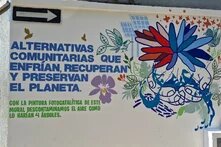The UN Conference on Biological Diversity (COP16) in Cali, Colombia, ended in early November with important resolutions, but no agreement on the key issue of financing biodiversity conservation.

After two weeks of marathon negotiations, including an extension, the UN Biodiversity Conference (COP16) in Cali ended on Saturday, November 2, 2024. The conference was tasked with taking important decisions related to the Global Biodiversity Framework signed by 196 countries in Montreal two years ago. Its goal: to avert the imminent loss of one million species – more than at any other time in human history. Land-use change, climate change, pollution and invasive species are just some of the factors threatening biodiversity and thus the lives of billions of people. COP16 was also intended to advance the follow-up framework and mobilize further resources for the Global Biodiversity Framework. Another goal was to finalize and implement the multilateral mechanism for the fair and equitable sharing of profits arising from the use of digital genetic information.
The world is far from meeting its 2030 environmental goals
A key goal of the 2022 Kunming-Montreal Agreement is to protect 30 percent of land and sea areas by 2030. A report released in time for COP16 by the UN Environment Programme’s World Conservation Monitoring Centre confirms that the planet is far from achieving this goal. The Protected Planet Report 2024 shows that 17.6 percent of the world’s land and inland waters and 8.4 percent of marine and coastal areas are protected. By COP16, the 196 Parties were to have aligned their strategies and action plans with the Kunming-Montreal Global Biodiversity Framework. However, only 17.3 percent of countries had submitted their plans.
During the conference, UN Secretary-General António Guterres called for an end to the “existential crisis” leading to the destruction of nature. He described the global environmental crisis as a “war against nature” in which there can be “no winners”. Guterres warned that “the drivers of this destruction are rooted in outdated economic models that encourage unsustainable production and consumption patterns. This devastation is only intensified by inequalities in wealth and power. And with each passing day, we are edging closer to tipping points that could fuel further hunger, displacement, and armed conflicts.” He called on countries to present clear plans for adapting to global biodiversity targets and to promote the mobilization of financial resources, not only from public sources but also from the private sector. “Biodiversity is humanity’s ally. We must move from plundering it to preserving it,” he said.
Biodiversity fund blocked
A major focus of COP16 was negotiations on the financing of biodiversity targets and a mechanism to achieve them. Colombian Environment Minister Susana Muhamad’s proposal to establish a global biodiversity financing mechanism under the authority of the Conference of the Parties to the CBD (COP CBD), which would give developing countries a greater say in the distribution of funds, was rejected by the so-called industrialized countries, including the EU, Switzerland and Japan. The UN Conference on Biological Diversity (COP16) in Cali, Colombia, thus ended without an agreement on the central issue of financing biodiversity conservation. Observers once again questioned the negotiating system of the COP. The loss of confidence in the industrialized countries on the part of the global South is likely to be considerable, giving us a foretaste of the confrontations to be expected at the UN Climate Change Conference (COP29) in Baku in mid-November.
Another issue that remained unresolved at COP16 was the establishment of a monitoring system for the Global Biodiversity Framework adopted at COP15 in Montreal, which set 23 targets for nature conservation. This leaves us without a clear roadmap for following up and implementing the national biodiversity strategies and action plans that signatory countries were supposed to present at the Cali conference.
Important decisions
Conference participants (including Ambiente y Sociedad) hailed as historic the decision to establish a standing committee and the 2030 work plan for Article 8J of the Convention, which will take greater account of the traditional knowledge of Indigenous peoples and local communities and support their practices to conserve and restore biodiversity. The decision to strengthen the role of African communities in the implementation of the Convention was also welcomed.
Progress has also been made in meshing biodiversity and climate protection. Cooperation at the policy, planning and implementation levels and between the Intergovernmental Science-Policy Platform on Biodiversity and Ecosystem Services (IPBES) and the UN Intergovernmental Panel on Climate Change (IPCC) will be intensified, and synergies between the implementation of National Biodiversity Strategies and Action Plans (NBSAPs) and Nationally Determined Contributions (NDCs) will be put to better use in the future.
It was also decided to operationalize the multilateral benefit-sharing mechanism related to the use of digital sequence information (DSI) and to establish the Cali Fund. This fund is intended to reduce the biodiversity financing gap and benefit countries with high biodiversity – including Indigenous and local communities.
Other decisions taken at COP16 include agreement on a better process for identifying and protecting marine areas of high biological value.
During the conference, organizations from countries in the Amazon region also launched the G9, a coalition of Amazon Indigenous peoples. The group advocates for direct funding mechanisms for the Indigenous peoples of the Amazon region, the strengthening of the legal security of their territories, and their participation in international negotiations.
The COP of the people
For months, Susana Muhamad campaigned tirelessly for the broad participation of the population and civil society actors in the COP and in the run-up to the summit under the slogan COP de la gente (COP of the people). Indeed, Colombia broke records: the Blue Zone – where the formal negotiations took place – saw more than 12,000 participants, and the Green Zone – which was open to the wider public, especially civil society – welcomed more than 900,000 visitors to hundreds of forums, seminars and cultural events.
The massive national mobilization created greater environmental awareness in Colombian society, while providing an unprecedented space for national and international social and environmental actors and ethnic groups to present their positions and engage in networking. The numerous events organized by an alliance of civil society partners of the Heinrich Böll Foundation’s Bogotá office in the Green Zone were also met with long queues, and not all visitors could fit into the rooms.
A civil society alliance supported by the Foundation presented the Ministry of the Environment with recommendations for the Colombian biodiversity plan and a list of demands for community-based sustainable management of common property to protect biodiversity and the climate. The right to self-determination of local communities and Indigenous and Afro-Colombian peoples plays a central role in their demands.
Susana Muhamad noted that in this #COPDeLaGente, she has received more than 30 statements, manifestos and policy papers from different sectors, which will be published as a testimony of global mobilization and commitment. “This is just the beginning of a post-COP agenda that will call us all to action,” she said.
Many organizations also stressed the urgent need to involve children, youth and women in the conferences and to support them in their commitment to protect biodiversity. This will determine whether the environmental conditions that have benefitted human civilizations for millennia will continue beyond this century. But here, too, there is a lack of dedicated funding to support their efforts.
Debt relief for climate action
During the opening ceremony of the world summit on biodiversity, Colombian President Gustavo Petro highlighted his proposal to swap debt for climate action. “Reducing the risk of debt in the Third World is important today. When the capital and pension funds of rich countries base their profitability on the economies of poor countries, they leave humanity without the tools to tackle the climate crisis,” the head of government said in his speech.
A little later, at a press conference in the second week of the conference, Colombian Foreign Minister Luis Gilberto Murillo explained that debt cancellation for investments in climate protection had been agreed with Germany at a meeting with the German State Secretary in the Development Ministry (BMZ), Jochen Flasbarth. It was also agreed that the two countries, together with France and Ghana, would set up an expert group to explore innovative mechanisms to swap debt for climate action in order to achieve debt relief that leaves more room for investment, biodiversity conservation and crisis management. This decision would follow the recommendations of the Expert Review on Debt, Nature and Climate at COP28 in Dubai in December 2023.
German Environment Minister Steffi Lemke told Deutschlandfunk radio that Germany has so far provided USD 1.36 billion for conservation in the biodiversity-rich countries of the South. She hopes that the promised USD 1.5 billion will be reached. Whether this can be achieved in view of Germany’s difficult budget negotiations is questionable. Donor countries worldwide have pledged at least USD 20 billion per year from 2025, but so far only USD 15 billion has been made available.
What’s next – on the road to climate COP29
One of the legacies of Colombia, and that of Environment Minister Susana Muhamad in particular, is the elevation of COP16 to the level of a climate COP. Never before had a biodiversity conference been so popular. Colombia was able to prove that it was up to the logistical and security challenges of a mega-event. Despite fears, there were no major mishaps and no serious security incidents or attacks, as had been predicted by violent actors: Cali showed its best side. For two weeks, Colombia was at the center of the world’s attention and was able to consolidate its regional and international leadership in the environmental sector.
As at many other COPs, urgent decisions were postponed, and the question of financing remained unresolved. The frustration is great, despite many partial successes. The COP as an instrument is showing its age, and multilateralism appears to be a futile attempt to persuade countries to act together. But the fight against the extinction of species and the climate crisis cannot be won alone. It requires multilateral meetings and the full commitment of developed countries to meet their obligations. In a few days, the global community will gather in Baku, Azerbaijan, for the 29th session of the Conference of the Parties to the United Nations Framework Convention on Climate Change (COP29). It is expected to produce results on a new collective quantified target for climate finance and guidelines for the establishment of the new Loss and Damage Fund. Once again, much will depend on the actions of rich countries. One thing is clear: it is high time to make peace with nature and the climate!
You can find out more about “Biodiversity” in our focus on the topic here.
More information on COP16 on the website of our Bogotá office (in Spanish):
• Coalición colombiana de sociedad civil camino a la COP16 y COP30
• Podcast: Después del daño


